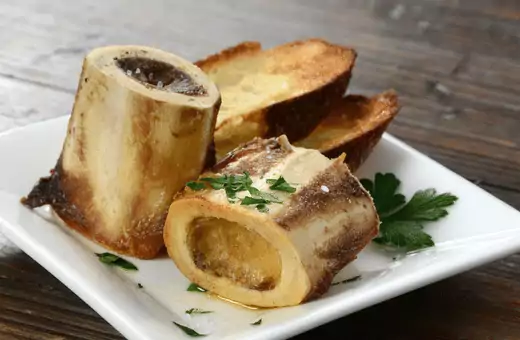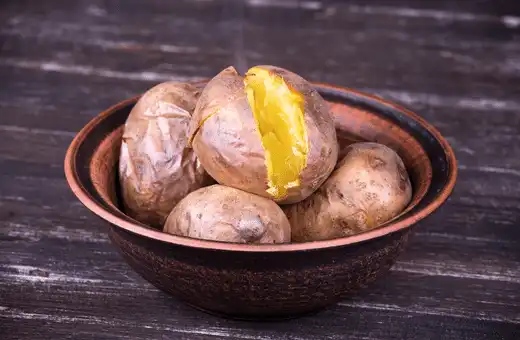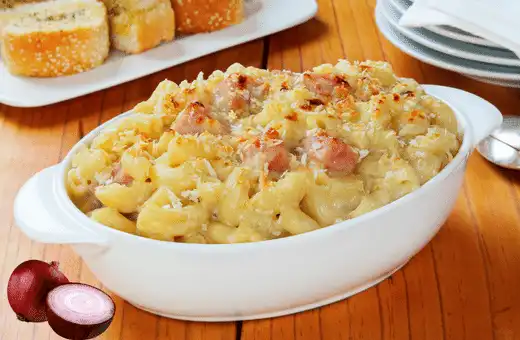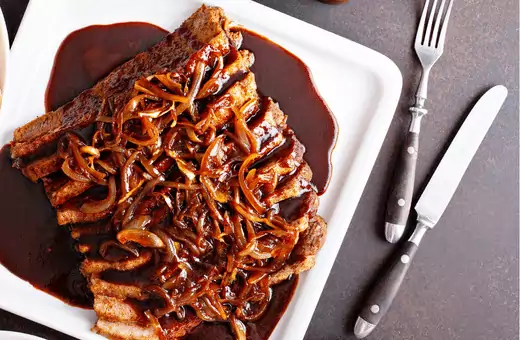Beef Wellington is a great option to make a show-stopping dish to make for a special occasion. It’s impressive and delicious and relatively easy to make.
Although there are many different recipes for Beef Wellington, the basic ingredients that remain the same include puff pastry, duxelles, and fillet steak.
Among them, duxelles is key for the delicious gravy in beef wellington. Duxelles are mainly made of mushrooms and mushroom stems.
But what if you don’t have any mushrooms or mushroom stems on hand?
Don’t worry! Here we will discussed about substitute for mushrooms in beef wellington, which will definitely make your taste buds dance.
So, just stay with me with your favorite balcony coffee.
What is Beef Wellington?
Beef Wellington is a classic English dish consisting of a fillet of beef tenderloin coated in a layer of pate and duxelles, wrapped in puff pastry, and baked. The dish is called after Arthur Wellesley, Duke of Wellington.
Beef Wellington is typically served with a sauce, such as Madeira or Béarnaise. It can also be served with vegetables, mashed potatoes, or rice.
Additionally, just be sure to give yourself plenty of time to prepare it, as it does take a bit of time to assemble.
What is so special about Beef Wellington?
Beef Wellington is a luxurious and indulgent dish that is perfect for a special occasion. The combination of tender beef and flaky pastry is simply divine, and the dish is sure to impress your guests.
The flavor of the beef mixed with the other ingredients in the dish can be truly delicious.
Although, it can be quite challenging to make, which can add to its appeal. It is a dish that is typically made with high-quality ingredients, which can make it even more special.
substitute for mushrooms in beef wellington
1. bone marrow – Best Substitute for Mushrooms in Beef Wellington
If you like to genuinely impress your guests, try substituting bone marrow for mushrooms. This will offer the dish an amazing flavor that you and your guests are sure to love.
Plus, it’s a fantastic method to get some extra protein into your meal.

Simply cook the marrow in a pan with some butter and garlic, and then spread it over the beef before wrapping it up in puff pastry. Your guests will be amazed at how delicious this dish is, and you’ll be glad you gave it a try.
So, what are you waiting for? Give it a try today!
2. Baked russet potatoes
When it comes to mushrooms, most people consider them to be an essential ingredient in beef wellington. Nevertheless, did you know that you can actually substitute baked russet potatoes for the mushrooms?

This is a great way to add a little bit of extra flavor and texture to your dish, and it’s also a great way to save on some of the prep time.
Simply bake your potatoes ahead of time and then slice them into thin strips before adding them to the rest of the ingredients.
This dish is usually made with russet potatoes, but you could use any type of potato that you like. If you’re not a mushroom lover, you could also use another vegetable, such as zucchini or eggplant.
To prepare the dish gluten-free, use a gluten-free pastry dough or wrap the beef wellington in bacon before baking.
Trust me, your guests will never know the difference!
3. anchovy paste- Suitable Mushroom Substitute in Beef Wellington
Anchovy paste is a salty condiment made from pulverized anchovies.

Try an umami flavor to your beef wellington; consider substituting anchovy paste for mushrooms. This swap will give your dish a deeper, more savory flavor that is sure to please.
Just be sure to use a little less anchovy paste than you would mushrooms, as the flavor can be quite strong.
Anchovy paste can be made at home by blending anchovies with olive oil, vinegar, salt, and pepper. It can also be bought in jars or tubes at most supermarkets.
When using anchovy paste, a little goes a long way. Start by adding just a small amount to your dish and then taste it before adding more. This paste can be quite salty, so be sure not to overdo it!
Anchovy paste is a versatile ingredient that can be used in all sorts of dishes. Try it in pasta sauces, salad dressings, or as a pizza topping. It’s also delicious spread on toast or crackers as a quick and easy snack.
4. Skip Mushroom
If you’re set on making a meaty Wellington, there are a few different ways to do it without the mushrooms.
One is to simply leave them out or get creative with other types of protein. Try using lobster, crab, or even tofu for a vegetarian version.
Another option is to use another type of vegetable in place of the mushrooms. Try using roasted Brussels sprouts, roasted cauliflower, or even-tempered cabbage.
5. a mixture of onions + bacon and cheese
a mixture of onions, bacon, and cheese is a good substitute for mushrooms in beef wellington. You could also use a combination of cooked spinach and crumbled feta cheese.

6. caramelized onions
Try substituting caramelized onions for the mushrooms. This will give the dish a richer, sweeter flavor that is sure to please your taste buds. To caramelize onions, simply cook them over low heat until they turn a deep golden brown color.

This method can carry up to an hour, so be patient! Once they’re finished, add them to your beef wellington recipe as directed.
Do you have to use mushrooms in beef, Wellington?
No, you don’t have to use mushrooms in beef Wellington. You can apply any kind of mushroom that you like or even leave them out entirely. The most crucial thing is to cook the beef properly so that it is juicy and tender.
Read More- substitute for mushrooms in pasta
Bottom Line Mushroom substitution in Beef Wellington
Mushrooms are a multipurpose ingredient that can be used in many different dishes. While they are often associated with beef wellington, there are many other dishes where mushrooms can be used as a delicious and healthy alternative.
When choosing a substitute for mushrooms in beef wellington, it is important to consider the other ingredients in the dish and how the mushrooms will work with them.
For example, while bone marrow and anchovy paste are popular choices for beef wellington, portobello mushrooms would also be a good option.
Whichever type of mushroom alternatives you choose, make sure to cook them properly, so they are tender and juicy.
FAQs related to substituting for mushrooms in beef wellington
Q1. Why is it called a Beef Wellington?
There’re many theories as to why this dish is called Beef Wellington. One theory is that it was named after the Duke of Wellington, who was known for his love of beef.
Another theory is that the recipe was created in Wellington, New Zealand, and thus named after the city. Whatever the case may be, this dish is sure to engrave your guests!
Q2. What cut of beef is best for Beef Wellington?
While there are a variety of cuts that can be used for Beef Wellington, the most popular and traditional cut is the filet mignon. This cut is taken from the shorter end of the tenderloin and is known for its rich flavor and tender texture.
When cooked properly, filet mignon will melt in your mouth, making it the perfect cut of beef for this dish.
Other cuts of beef that can be utilized for Beef Wellington include the rib eye, strip steak, and top sirloin. Whichever cut you prefer, make sure that it is of good quality and properly cooked to ensure a delicious and memorable meal.
Q3. Can I use phyllo dough instead of puff pastry for Beef Wellington?
Yes, you can use phyllo dough instead of puff pastry for Beef Wellington. Phyllo dough is a kind of pastry dough that is similar to puff pastry, but it is made with different ingredients.
Phyllo dough is produced with flour, water, and oil, while puff pastry is made with flour, butter, and water. Phyllo dough is also thinner and less flaky than puff pastry.
However, both types of dough can be used to make Beef Wellington. If you use phyllo dough, you may need to use more of it to cover the beef, and it will not be as crisp as if you used puff pastry.
Q4. What meat can you substitute for beef tenderloin?
Some good substitutes for beef tenderloin include pork loin, lamb loin, and chicken breast. These cuts of meat are similar in texture and flavor to beef tenderloin, making them ideal for dishes that call for this particular cut.
When substituting one of these meats for beef tenderloin, be sure to cook it to the same internal temperature to ensure food safety.
Pork loin and lamb loin should be cooked to an internal temperature of 145 degrees Fahrenheit. The chicken breast should always be cooked until it reaches an internal temperature of 160°F.

